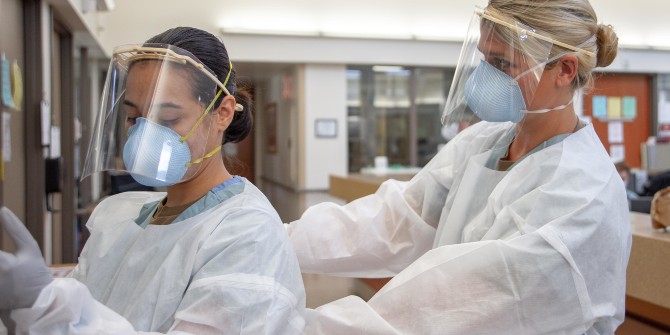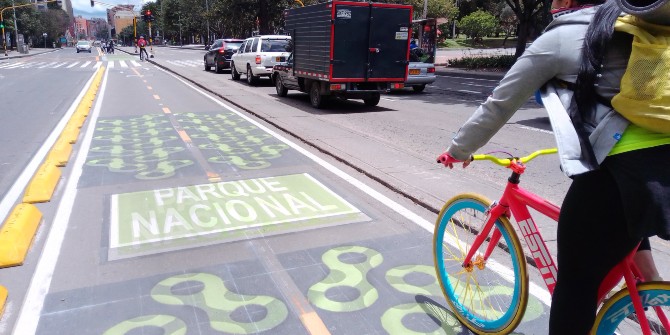We have adopted the catch-all term ‘vaccine hesitancy’ to talk about people who have not received COVID jabs. Policymakers assume that with better information people would choose to take the vaccine. Yet this ignores the complex factors at work in many communities, says Liz Storer (LSE).
Since COVID vaccines were first approved in early 2021, European governments have been focused on rolling out jabs and reaching vaccination targets. To these ends, they have pursued a host of policies to encourage vaccine uptake. In some cases, such as Italy and France, Green Passes or Vaccine Passes are now required to work or to access hospitality or long-distance transport. Passes are linked to an increasingly stringent governance of movement. Along with police at national borders, now transport operators, hoteliers and shop workers are involved in validating movement and the occupation of space.
As measures in Europe become more punitive, people continue to resist vaccines intensely. A new term, “vaccine hesitancy”, has emerged to encapsulate the diverse orientations, fears and resistance to COVID vaccination, though the phrase predates COVID. Yet it has now become central to policymaking, and denotes the links between individual decisions and the “infodemic”. According to this logic, people hesitate because of imperfect, poor or conspiratorial information which dissuades them from accepting a vaccine. If health messaging is improved, vaccine uptake will increase.
Yet in its focus on the individual, there is a risk that the notion of vaccine hesitancy sidelines the structural discrimination faced by the groups who are often among the most resistant to accepting vaccines. As Jean-Yves Durand and Manuele Ivona Cunha explain, if expressions of mistrust and experience are ignored in research agendas, those who reject vaccines are “reduced to ignorance, irrationality, irresponsibility”. Structural inequalities, which predated the pandemic and are known to have widened during the crisis, are hidden from view. Alongside this, accepting a vaccine is increasingly framed as a duty to protect the nation: to be vaccinated is to protect society. How, then, do people at the margins experience COVID vaccination and its regulation?
One of the Firoz Lalji Institute for Africa’s new Ethnographies of disengagement explores attitudes towards vaccines among Roma populations settled in Rome and Milan, migrants settled in Rome, and those seeking to cross Italy via its Alpine borders. As would-be migrants and the targets of historical and contemporary discrimination towards Roma, these groups inhabit the margins of the Italian state, or popular imaginations of who constitutes Italian society.
Since the start of the pandemic, their struggles have been erased or made invisible by datafied approaches to COVID. These have dominated our understandings of the European pandemic and structured responses to it. Groups labelled as vaccine ‘hesitant’ are deemed potential threats in spreading COVID.

With the recognition that these groups have been excluded from policy, there have been recent efforts to understand vaccine resistance among them. Policymakers have adopted a language of inclusivity in an attempt to encourage vaccine uptake. Some have noted the structural barriers to improving the health of these communities. A recent International Organization for Migration review, for example, notes that people who do not possess full citizenship in their country of residence often fear state bureaucracy, which may make them reluctant to engage with health authorities.
Yet on the ground groups continue to be targeted as hesitant individuals. The dominant focus has been on developing effective health literacy through communication interventions. The assumption is that if groups receive the correct information, then individuals may choose to take vaccines. Yet there has been little effort to tailor interventions to their needs, or fears, or to address the effects of inequality and exclusion.
In the case of COVID, rather than charting the social worlds and lived experiences through which decisions about vaccines emerge, much qualitative research assumes that health is the sum total of well-being
In contrast to previous pandemics, there is very little research which traces how ‘risk groups’ themselves perceive vaccines, or the agents of the health system or state delivering them. Research during the Ebola epidemic in West Africa demonstrated how both the virus – and the international response – ruptured what James Fairhead calls the “social accommodations” on which everyday existence relies, as well as essential mechanisms of care between loved ones. Research such as this placed the idioms and practices of people themselves at its centre. It recognised that health actors and state agents could be seen not as offering beneficial assistance, but as mediating violent disruptions to everyday life.
Of course, placing the ontologies and experience of interlocutors at the centre of research is a prerogative in anthropological research. Yet in the case of COVID, rather than charting the social worlds and lived experiences through which decisions about vaccines emerge, much qualitative research assumes that health is the sum total of well-being. With conventional ethnography itself immobilised by COVID restrictions, there have been endless conversations about the validity of remote methods – without focusing on, for example, wider definitions of well-being, or experiences of the state at the margins. This means that significant blind spots remain. As Gary Alan Fine and Corey M Abramson recognise, there is limited “deep” data to complement the now extensive sets of epidemiological “big” data that have dominated COVID analysis.
While we are interested in how individual and groups relate to COVID, our research uses this as a lens to expose wider understandings of health, inclusion/ exclusion and public authority. We found that speaking of vaccines in an open-ended way often led to conversations about ongoing disenfranchisement, fear and orientations of well-being which went far beyond vaccines alone.
It is only through placing these lived experiences at the centre – rather than promoting vaccines through coercion – that approaches to encouraging vaccination can promote trust in the state
For example, migrants passing through Italy often located concerns about COVID in wider frames connected to the often treacherous journeys they were forced to undertake from Afghanistan or other countries. Indeed, far from being vaccine ‘hesitant’, migrants had often taken vaccines to proceed with their journeys in countries such as Bosnia or Turkey, but the vaccine type was not eligible for a Green Pass in Italy. Idioms of well-being were connected to the journey, and vaccines were accepted or not, as they were connected to completing migrant trips.
Very different dynamics affected some Roma settlements in Italy. Here, in one case, COVID vaccines were being delivered as local governments simultaneously issued eviction orders in order to usher in private developments on their lands. Here, our interlocutors expressed extreme fears at their insecurity of tenure and the precarity of their futures. It was these immediate challenges to security which were at the centre of everyday concerns. While most recognised the health risks of COVID, in moments of intense insecurity, these concerns were at the margins of wider effects to stay safe.
Crucially, too, while policymakers assume that those at the margins mistrust vaccines, we found significant evidence to the contrary. Often people engaged with vaccines – or not – as these decisions coalesced with their wider notions of survival.
In subsequent posts in this series, we trace how wider experiences of disengagement can be considered alongside health policies. It is only through placing these lived experiences at the centre – rather than promoting vaccines through coercion – that approaches to encouraging vaccination can promote trust in the state. If not, there is a risk that COVID vaccination attempts are seen by the vulnerable as an extension of discrimination which people have long faced at the margins.
This post represents the views of the author and not those of the COVID-19 blog, nor LSE. It is the first of four posts on the LSE’s Ethnographies of (Dis)Engagement project.





